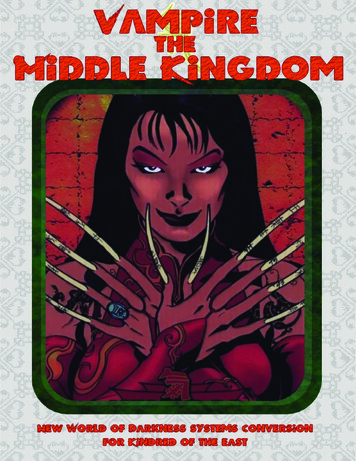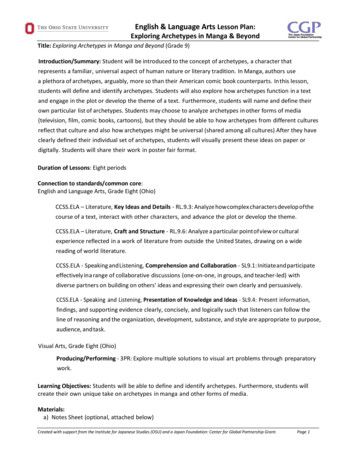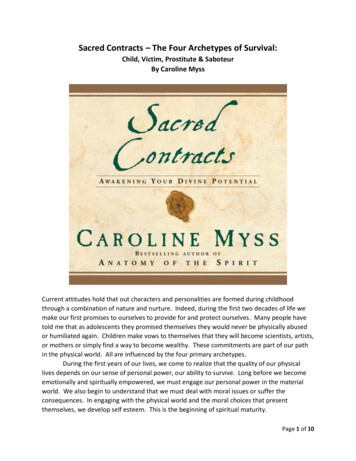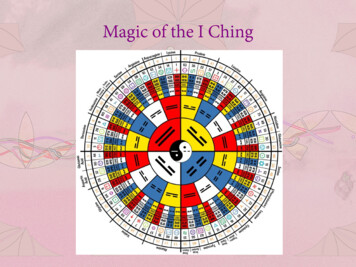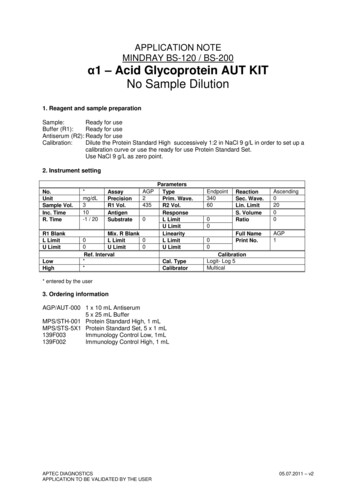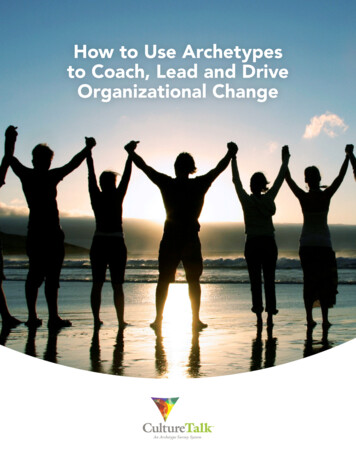
Transcription
How to Use Archetypesto Coach, Lead and DriveOrganizational Change
Table of Contents347101314Welcome to CultureTalkPart 1: An Introduction to ArchetypesPart 2: Applying Personality ArchetypesPart 3: Applying Cultural ArchetypesPart 4: The CultureTalk SystemReady for more?2
Welcome to CultureTalk !TMThank you so much for grabbing this free guide on “How To Use Archetypes to Coach, Lead, andDrive Organizational Change”.We are Cynthia and Theresa, co-founders of CultureTalk (and actual sisters).We are both students and teachers of ‘culture’ and we believe culture is the ultimate organizationalnavigating system. But before culture became our passion, we ran a business for almost 20 yearsthat helped organizations and leaders build meaningful brands.We did that by measuring the culture in an organization and letting the brand story emergefrom the culture. It was a powerful and impactful process that had clients asking us to come backagain and again. Helping them uncover the deeper layers of their culture made such an impactthat they wanted to use their story to: Recruit and hire On-board and engage Lead and grow Merge and shiftWhat we came to see was that the framework of Archetypes – which is grounded in storytelling –could be used more broadly to address many, connected business challenges.That’s why we started CultureTalk — a leadership and culture training and developmentplatform that uses the power inherent in Archetypes. CultureTalk’s framework provides a shortcutto understanding human motivation and behavior and helps organizations bridge strategy withexecution.In this guide, “How to Use Archetypes to Coach, Lead and Drive Organizational Change”,we’ll introduce you to Archetypes and share how this framework can be applied to transformingindividuals, teams, cultures and brands.Here’s to helping individuals and organizations grow, evolve and thrive!Cynthia ForstmannTheresa Agresta3
Part 1: An Introductionto ArchetypesArchetypes are human story lines that we can all recognize and relate to.They are like fingerprints; nuanced and unique. They are deep, multi-layered,and detailed profiles of both individuals and organizations.Carl Jung first postulated that ‘Archetypes’ exist. A Swiss psychiatristprominent in the early to mid-1900’s, Jung was also an expert in myth andsymbology. He studied cultures across the ages, noting many shared patterns,themes and symbols that were also present in the day-to-day experiencesand struggles of his patients.Jung proposed that the human mind is not exclusively the product of personalexperience, but rather contains elements, which are common to all humans.These elements he called the ‘Archetypes’ and he proposed that whileunconscious, these ‘cognitive categories’ influence our thoughts, behaviors,and the way we look at the world.Here’s a quick background(but skip to page 7 if youjust want to get straight tothe business applications!)“Archetypes,” he wrote “are images and thoughts which have universalmeanings across cultures.”Jung said these story lines provide structure for human experiences. Hebelieved becoming aware of how Archetypal patterns are playing out in ourown lives is the path to expanding consciousness.Many philosophers and teachers from Joseph Campbell to Carolyn Myss haveexpanded on Jung’s concept, creating their own names, categories or systemsfor applying Archetypes to help us answer the age-old questions of ‘who am I?’and ‘where do I belong?’But it was Carol Pearson who brought Archetypes into the modern businessworld. A researcher, author and educator, she led women’s and leadershipstudies programs at the University of Colorado, the University of Marylandand Georgetown University among others. She later became the president ofPacifica Graduate Institute which specializes in post graduate Jungian studies.Through her academic research and work, Pearson uncovered 12 Archetypesthat were most common in leadership and organizational settings. She haspublished numerous books about how to apply Archetypal narrativeintelligence towards personal growth and organizational alignment. It isPearson’s 12-Archetype framework that we use in our work at CultureTalk.4
Applying Archetypes to Develop People and OrganizationsWhether we are working with individuals, leaders, teams or even across an organization,Archetypes provide a solid foundation for personal growth and organizational change.Here are four key concepts when working with Archetypes:1) A R CH E T Y PE S A R E S TO R I E S .Neuroscience shows that ‘story’ is the way our brains process information. Even when given a listof facts - our brains translate facts into stories in order to make them memorable and meaningful. Inbrain imaging studies our neural networks get lit up on stories.2) E ACH A R CH E T Y PE H A S S T R EN G T H S A N D S H A D OW S .Just like human beings – Archetypes are rich and colorful, but also flawed and relatable. They eachhave their own motivations and strengths, but they also have and blind spots or shadows traits.3) W E H AV E T H E C A PACI T Y F O R A L L 12 A R CH E T Y PE S .One or more of these Archetypes may be related to an individual’s or organization’s core identity,while others may shift over time in response to phases of life or business – or in response to situationsencountered.4) L AT EN T A R CH E T Y PE S C A N B E AC T I VAT E D.Knowing which Archetypes are less active in an individual or organization can shed light onperspectives and skills that are missing.With these key concepts in mind, let’s look at how we can apply Archetypeswith individuals and groups to drive organizational change.5
The 12 Archetypes of CultureTalkArchetypeGuiding VisionFavorite PhraseInspired ByFrustrated ByExamplesTo make sure allneeds are metLend a hand inany situationCompassion,kindness andgenerosityPeople wholive only forthemselvesMary Poppins/VolvoTo createsomething outof nothingWith imagination,anything is possibleSeeing theconnections withinthe chaosPoor designDaVinci/LegoTo make surethings are fairand equalWhen we standtogether, wealways winSuccess of thecommon manor womanElitismMalala Yousafzai/Tom’s ShoesTo go whereno one has gonebeforeBecause it’s there!The horizonCommitmentsSir Edmund Hillary/NationalGeographicTo protect, toserve, to winDamn thetorpedoes, fullsteam ahead!A cause or wouldbe obstaclePeople whogive upJames Bond/NikeTo trust thatthings always workout for the bestDon’t worrybe happy!Simple pleasuresNegativityThe Dali Lama/IvoryTo keep it lightand make it funLaugh andthe world laughswith youSpeaking truthto powerPeople who takelife too seriouslyRobin Williams/ZapposTo createmeaning throughconnectionFollow your blissHarmony andpeace-makingUnwillingness tobe vulnerableJennifer Lopez/Tiffany & CoTo see the realityin what seemslike fictionImpossible is onlya state of mindSeeing ideas comeinto fruitionOld schoolthinking, nonbelieversTony Robbins/DisneyTo challenge thestatus quoThere has to be abetter wayTroubleshootingFear of changeMartin Luther King/AppleTo take chargeand leadMy way or thehighwayClarity and keepingthings runningsmoothlyAimlessnessand lack ofaccountabilityJeff Bezos/Mercedes BenzTo know moretomorrow thantodayYou are nevertoo old to learnsomething newIntelligentpeople and wellresearched ideasMisinformationAlbert Einstein/Mayo Clinic6
Part 2: ApplyingPersonality ArchetypesStories Create Quick UnderstandingEven just scanning the list on the previous page, can you already guess what each of these storylines is about? Heroes save the day. Magicians transform. Revolutionaries break boundaries.And you likely relate to some of these stories more than others. Whatever Archetypes areactive in you (or in others) provide the lens through which you interpret the world. This lens alsodetermines what gets noticed and what gets filtered out. Archetypes provide a shortcutto understanding ourselves, our teams and our organizations.7
Following are 4 ways coaches, trainers, and consultants are usingPersonality Archetypes to drive organizational change.1 Hire and RetainThe cost of recruiting and retaining high potential employees is significant. The cost of losing a new hirein year one is 50% to 75% of their salary. And we’ve all heard the dismal engagement stats (upwards of 66%of employees are disengaged)!Today, there is also a growing demand for diversity to move beyond hiring stats towards a focus onbuilding teams where people feel a sense of belonging.H OW C A N PER S O N A L I T YA R CH E T Y PE S H EL P ? Onboard for ImpactAdopting Archetypes can help companies builddefine where they fit on the team and in the overalla better process for hiring, on-boarding andengaging new employees on diverse teams,speeding uptime for a productive hire, reducingregrettable attrition, and saving costs on mishiring. Strengthen InterviewsWhile an Archetype assessment should not beused as a screening tool, it can help interviewersget to know a candidate more quickly by givingthem insights about motivational patterns, openingOnboarding programs should help new employeesculture, and how they can best contribute. Byunderstanding their Archetypes, new employeesexperience an immediate investment in theirdevelopment. Deepen Diversity and EngagementArchetypes provide a new lens by uncoveringdiversity of motivation and thought. As teams learnthe patterns, there is a growing appreciation forunique perspectives and contributions.up lines of inquiry and accessing culture fit.2 Define Purpose and Personal BrandSimon Sinek famously said, “People don’t buy what you do, they buy why you do it.” And a myriad of studiessupport the idea that meaning and purpose are more important to productivity than a paycheck.In the age of social profiles, every person has a brand and every employees’ brand becomes a reflection onthe organization. Aligning personal purpose and brand with an organization’s enhances motivation andengagement.H OW C A N PER S O N A L I T Y A R CH E T Y PE S H EL P ?Archetypes are uniquely suited for defining purpose and brand – they are stories that align strengths andvalues, that shape motivation and engagement. An individual’s core Archetypes already contain the answerto who, why and what. And certainly, the storylines themselves provide a rich blueprint that can be appliedto a personal brand!8
3 Grow and LeadToday, the fluid nature of teams and the imperative of effective collaboration means soft skills and emotionalintelligence are highly valued.H OW C A N PER S O N A L I T YA R CH E T Y PE S H EL P ?Archetypes enhance self-awareness, narrativeintelligence and personal growth. Problem SolvingSometimes a recurring problem needs a newapproach. Learning to activate Archetypes outsideyour core profile opens new possibilities. Uncovering Shadow Traits Leveling Up ResponsesArchetypes bring our blind spots into focus,In each triggering moment, are we above the linealong with the opportunity to manage them inthe moment and over time.(empowered and coming from strengths) or belowthe line (disempowered and coming from shadow)? Illuminating Unconscious Bias Growing the TeamWe see the world through our own ArchetypalLeaders can leverage these patterns to alignlens, which can also lead to ‘filtering out’ otherperspectives or even rejecting them as not true.work assignments, strengthen collaborations andchallenge growth. Archetypes provide a freshtake to professional development plans that areactionable and tactical.4 Connect and TeamStudies on teamwork continue to show that trust is fundamental to making teamwork work. Google’sProject Aristotle, Daniel Coyle’s Culture Code, and Patrick Lencioni’s The Five Dysfunctions of a Team, allname psychological safety, and a willingness to be vulnerable as important ingredients to building trust.H OW C A N PER S O N A L I T YA R CH E T Y PE S H EL P ? Appreciate diversity and grow compassionAs a human framework, Archetypes allow peopleArchetypes teach teams the limits of their ownto show up fully, safely and uniquely. Coaches,lens and the value of diverse points of view; theyconsultants and in-house trainers can introduceenhance patience and compassion.Archetypes to help team members understandhow they interact, where their motivationsintersect and how are they wired differently.Specifically, Archetypes help teams: Collaborate through strengthsAs we get to know which Archetype does whatbest, roles and responsibilities can be alignedwith the person best suited to the task. Get to know each other better and faster Resolve conflictArchetypes allow teams to share the stories ofArchetypes create an objective lens to understandtheir lives in a way that help others understandhow experiences have shaped their perspectives.conflict. We see how different patterns see theworld differently.9
Part 3: ApplyingCultural ArchetypesCarl Jung observed that Archetype patterns are also present in the collective, “Archetypesshow up as personality in individuals,” he said, “and as culture in groups.”Think about your own organization or another group that you are part of – can you guesswhich one or more of these 12 Archetypes might be most active? Think about the organization’smission, leadership or reputation. What are they known for? What does it feel like tobe part of that group?We find this framework to be effective in organizations because the Archetypes provide ashortcut to understanding. Everyone gets on the same page quickly about the ‘type’ of culturethat exists in their group. And once they understand their type, it gives them a language forhow to talk about their culture in a meaningful way.10
Following are 4 ways coaches, trainers, and consultants are usingCultural Archetypes to drive organizational change.1 Brand and MarketSocial media and the internet have created a ’glass box’ where everyone can see everything that happensinside a company. The public is demanding alignment and authenticity between what a brand says aboutitself and how it behaves. And when it comes to its brand reputation, a company’s culture has become itsmost valuable asset or biggest liability.H OW C A N CU LT U R A LA R CH E T Y PE S H EL P ?When they define values, strengths and shadowsthrough Archetypes, organizations are able tolet the story emerge from the culture and provide arich blueprint for concepts, colors, words and more. Employment and talent brands, toomanage their brand with intention.When it comes to talent, culture and brand are Purpose-driven missionssynonymous. Archetypes can help companiesEach Archetype has a distinct core motivationalculture and attracts strong-fit employees.pattern that answers the question ‘why’ and drivesbehavior. For the Everyperson culture – it’s justice.frame and tell a story that showcases the authentic What to watch out forFor the Lover – connection. For the Sage – truth.If a culture demonstrates the strengths of an Authentic brands from the inside outArchetype pattern, it is also susceptible to itsBrands are stories, but you can’t make aculture focused on winning can become a placemeaningful story appear out of thin air. Archetypesof unhealthy competition or burn-out.shadow behavior. For example, the tireless Hero2 Evolve and ShiftStaying relevant in any business environment requires organizations to change; but changing behavior can behard unless we understand the underlying cultural drivers that sustain the current way of doing things.H OW C A N CU LT U R A L A R CH E T Y PE S H EL P ?Archetypes help organizations name the existing culture and how those patterns show up as strengths orshadows. They translate a subjective and intangible feeling into a tangible, objective cultural profilethat details what’s moving us forward, what’s holding us back and what’s missing in order for new behaviorsto emerge.Leaders can then identify specific behaviors that need to shift to achieve the ‘will be’ culture, as well asstrategies for enabling that shift. These change strategies can be framed by which Archetypes need to bedialed up or down, or what Archetypes need to be developed.11
3 Merge and IntegrateMergers and acquisitions are a popular path to growth, but stats suggest the vast majority, up to 80%,never deliver on expected returns. ‘Misaligned cultures’ is often cited as the primary obstacle to success.H OW C A N CU LT U R A L A R CH E T Y PE S H EL P ?A Baseline Culture Audit, whether it is part of due diligence or a post-merger integration strategy, canbe designed to look at two original cultures objectively. Through measuring Archetypal patterns andvalidating behaviors, we can draw a side-by-side comparison to the ‘unwritten rules’ that influence howeach organization behaves.Through this non-judgmental framework, leaders can identify areas of potential conflict that need tobe addressed.4 Team-to-TeamSubcultures are common in organizations, even those that have a clearly defined purpose and brand. Subcultures can be positive when they support the work of a particular team or department. But they can alsoseed conflict between groups.H OW C A N CU LT U R A L A R CH E T Y PE S H EL P ?We can add demographic question sets to a CultureTalk assessment to explore the different patterns thatmay exist between groups. The Archetypes provide an unbiased way of exploring tensions and enhancingcollaborations. By understanding the motivations behind behavior, groups can develop strategies thatsupport the overall goals of the organization.For example, a sales department that scores high on Explorer may rely on innovations developed by the R&Dteam that scores high on Sage.12
Part 4: TheCultureTalk SystemCultureTalk is a training and development platform that applies Archetypes to the positivegrowth of leaders, teams, brand and cultures.The platform includes assessment tools, coaching, and consulting frameworks and ready-togo workshops with facilitation materials. The CultureTalk System is delivered through aninternational community of coaches, consultants, and in-house trainers. Through our signatureCertification Program, Certified Partners learn how to apply the simple, yet practical, storybased framework of Archetypes for measuring culture and translating it into a strategicasset that can be designed, shifted, operationalized, and led.Individual AssessmentThe CultureTalk for Individuals assessment is designed to measure Archetypalpatterns that come to life through individual personality and perspective. Unlikeother personality assessments, this tool does not seek to put people in a box or‘type’ them through a narrow lens. We recognize that each person’s story is multidimensional which is why we provide scores across all 12 Archetypes.Through the assessment itself and guided reflection exercises, coaches andconsultants can help individuals uncover their core, supporting and latent Archetypes.Each person can then create a unique profile as a way of understanding their ownmotivations, values, strengths and shadows, blind spots and biases.Organizational AssessmentThe CultureTalk for Organizations assessment is designed to measure the sharedexperiences of a group, especially ‘the unwritten rules of engagement’ – what weactually do, versus what we say we do.Unlike other culture assessments, this tool does not pass judgment on a cultureas good or bad, right or wrong. Rather, it recognizes that every culture is multidimensional with the capacity for greatness as well as challenging behaviors thatneed to be minimized and managed.13
Ready for more?Here are three opportunities to dig deeper!1 Discover your Archetypes (and how to use them most effectively)with our mini e-course – An Introduction to ArchetypesThe quiz you took offered one potential Archetype that might be part of your story along with a snapshot ofwhat that means. However, each person is a unique combination of patterns and to really use this work, you needto dive deeper.T H I S CO U R S E I N CLU D E S: Our full 72-question CultureTalk for Individuals Archetype assessment A robust report with: Your score across all 12 Archetypes An Overview of your top Two ith a link to their full reports Your Archetype in Relationship An Overview of your Latent Archetype Your Archetype at Work Course videos that offer a deep dive on each of the 12 Archetypes We will walk you through a simple validation experience that allows you to identify your Core and SupportingArchetypes, develop a personal purpose, or brand statement and create a personal growth action plan.To sign up, click here.2 Get Certified and bring CultureTalk to your clients!If you are a coach, trainer or consultant curious about bringing Archetypes into your leadership, team andculture-building initiatives, our CultureTalk Certification is our pride and joy.The CultureTalk Certification is an 8-week advanced certification that has helped so many businesses,organizations, consultants, and coaches offer more value, provide better services for their clients, and standout in the market place—all through creating a framework of culture.It offers a simple, yet practical, story-based framework for measuring organizational culture and translatingit into a strategic asset that can be designed, shifted, operationalized, and led.Check out the details for our CultureTalk Certification program here.3 Hire a Certified PartnerIf you’d like to learn more about bringing this system into your organization, we’d love to connect you withone of our CultureTalk Certified Partners.Thank you so much for reading this guide and we hope you got value out of this for your business, your clients,or your own personal benefit.Stay in touch and if you have any questions or want to learn moreabout any of our offerings feel free to reach us at:Cynthia — Cynthia@culturetalk.com Theresa — Theresa@culturetalk.com14
Drive Organizational Change". We are Cynthia and Theresa, co-founders of CultureTalk (and actual sisters). We are both students and teachers of 'culture' and we believe culture is the ultimate organizational navigating system. But before culture became our passion, we ran a business for almost 20 years
